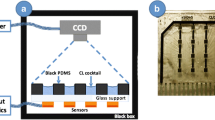Abstract
This study developed a packaging method to integrate the extended-gate field-effect transistor (EGFET) into a microfluidic chip as a biological sensor. In addition, we present two immobilization approaches for the bio-recognition that are appropriate to this chip, allowing it to measure the concentrations of hydrogen ions, glucose, urea, and specific proteins in a solution. Alginate-calcium microcubes were used to embed the enzymes and magnetic powder (enzyme carrier). When the sensing chip needs the enzyme for the catalytic reaction, the alginate microcubes containing the corresponding enzymes enter through the flow channel and are immobilized on the EGFET surface with an external magnet. High sensing performance of the chip is achieved, with 37.45 mV/mM for measuring hydrogen ions at pH 6–8 with a linearity of 0.9939, 7.00 mV/mM for measuring glucose with a linearity of 0.9962, and 8.01 mV/mM for measuring urea with a linearity of 0.9809. In addition, based on the principle of the immunoassay, the magnetic beads with the specific antibody were used to capture the target protein in the sample. Then, negatively charged DNA fragments bound to a secondary antibody were used to amplify the signal for EGFET measurement. The magnetic beads with completed immune response bonding were then fixed on the surface of the sensor by an external magnetic field. Therefore, the measured object can directly contact the sensor surface, and quantitative detection of the protein concentration can be achieved. Apolipoprotein A1 (APOA1) was detected as a target protein, with a minimum detection limit of approximately 12.5 ng/mL.







Similar content being viewed by others
References
A.W. Adamson, Physical adsorption of vapors - three personae. Colloids Surf A Physicochem Eng Asp 118(3), 193–201 (1996)
P. Bergveld, Development of an ion-sensitive solid-state device for neurophysiological measurements. IEEE Trans Biomed Eng 1(BME-17), 70–71 (1970)
F. Bettaieb, L. Ponsonnet, P. Lejeune, H.B. Ouada, C. Martelet, A. Bakhrouf, N. Jaffrezic-Renault, A. Othmane, Immobilization of E. coli bacteria in three-dimensional matrices for ISFET biosensor design. Bioelectrochemistry 71(2), 118–125 (2007)
Y.-T. Chen, H.-W. Chen, D. Domanski, D.S. Smith, K.-H. Liang, C.-C. Wu, C.-L. Chen, T. Chung, M.-C. Chen, Y.-S. Chang, Multiplexed quantification of 63 proteins in human urine by multiple reaction monitoring-based mass spectrometry for discovery of potential bladder cancer biomarkers. J Proteome 75(12), 3529–3545 (2012)
J. Fritz, Cantilever biosensors. Analyst 133(7), 855–863 (2008)
C.D. Fung, P.W. Cheung, W.H. Ko, A generalized theory of an electrolyte-insulator-semiconductor field-effect transistor. IEEE Trans Electron Devices ED-33(1), 8–18 (1986)
S. Hideshima, R. Sato, S. Kuroiwa, T. Osaka, Fabrication of stable antibody-modified field effect transistors using electrical activation of Schiff base cross-linkages for tumor marker detection. Biosens Bioelectron 26(5), 2419–2425 (2011)
C.-J. Huang, Y.-H. Chen, C.-H. Wang, T.-C. Chou, G.-B. Lee, Integrated microfluidic systems for automatic glucose sensing and insulin injection. Sensors Actuators B Chem 122(2), 461–468 (2007)
M. Ikeda, N. Yamaguchi, K. Tani, M. Nasu, Rapid and simple detection of food poisoning bacteria by bead assay with a microfluidic chip-based system. J Microbiol Methods 67(2), 241–247 (2006)
H. Li, C. Li, H. Wu, T. Zhang, J. Wang, S. Wang, J. Chang, Identification of Apo-A1 as a biomarker for early diagnosis of bladder transitional cell carcinoma. Proteome Sci 9(1), 21 (2011)
Y.-H. Lin, P.-Y. Peng, Semiconductor sensor embedded microfluidic chip for protein biomarker detection using a bead-based immunoassay combined with deoxyribonucleic acid strand labeling. Anal Chim Acta 869, 34–42 (2015)
Y.-H. Lin, S.-H. Wang, M.-H. Wu, T.-M. Pan, C.-S. Lai, J.-D. Luo, C.-C. Chiou, Integrating solid-state sensor and microfluidic devices for glucose, urea and creatinine detection based on enzyme-carrying alginate microbeads. Biosens Bioelectron 43, 328–335 (2013)
F. Lucarelli, G. Marrazza, A.P. Turner, M. Mascini, Carbon and gold electrodes as electrochemical transducers for DNA hybridisation sensors. Biosens Bioelectron 19(6), 515–530 (2004)
T.-M. Pan, M.-D. Huang, C.-W. Lin, M.-H. Wu, Development of high-κ HoTiO 3 sensing membrane for pH detection and glucose biosensing. Sensors Actuators B Chem 144(1), 139–145 (2010)
D.G. Pijanowska, W. Torbicz, pH-ISFET based urea biosensor. Sensors Actuators B Chem 44(1), 370–376 (1997)
M.J. Schöning, A. Poghossian, Recent advances in biologically sensitive field-effect transistors (BioFETs). Analyst 127(9), 1137–1151 (2002)
Z.E. Selvanayagam, P. Neuzil, P. Gopalakrishnakone, U. Sridhar, M. Singh, L.C. Ho, An ISFET-based immunosensor for the detection of β-bungarotoxin. Biosens Bioelectron 17(9), 821–826 (2002)
H.-H. Tsai, C.-F. Lin, Y.-Z. Juang, I.-L. Wang, Y.-C. Lin, R.-L. Wang, H.-Y. Lin, Multiple type biosensors fabricated using the CMOS BioMEMS platform. Sensors Actuators B Chem 144(2), 407–412 (2010)
J. van der Spiegel, I. Lauks, P. Chan, D. Babic, The extended gate chemically sensitive field effect transistor as multi-species microprobe. Sensors Actuators 4(C), 291–298 (1983)
J. Yeh, Y. Ling, J.M. Karp, J. Gantz, A. Chandawarkar, G. Eng, J. Blumling Iii, R. Langer, A. Khademhosseini, Micromolding of shape-controlled, harvestable cell-laden hydrogels. Biomaterials 27(31), 5391–5398 (2006)
H. Zhang, L. Liu, X. Fu, Z. Zhu, Microfluidic beads-based immunosensor for sensitive detection of cancer biomarker proteins using multienzyme-nanoparticle amplification and quantum dotslabels. Biosens Bioelectron 42, 23–30 (2013)
Acknowledgments
The authors would like to thank the Ministry of Science and Technology of Taiwan and Chang Gung Memorial Hospital for their funding support (No. MOST 103-2221-E-182-016-MY2, CMRPD2C0091).
Author information
Authors and Affiliations
Corresponding author
Rights and permissions
About this article
Cite this article
Lin, YH., Chu, CP., Lin, CF. et al. Extended-gate field-effect transistor packed in micro channel for glucose, urea and protein biomarker detection. Biomed Microdevices 17, 111 (2015). https://doi.org/10.1007/s10544-015-0020-4
Published:
DOI: https://doi.org/10.1007/s10544-015-0020-4




